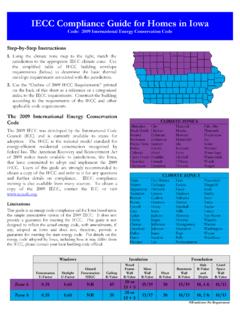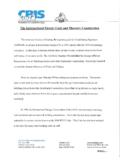Transcription of 2012 IECC Commercial: Overview and Changes
1 1 April 2014 Presented by Dave Houser Dale Horton, Architect National Center for Appropriate Technology 2012 IECC commercial : Overview and Changes 3 ..shall regulate the design and construction of buildings for the effective use and conservation of energy over the life of each building. 4 Organization of 2012 IECC ChapterCommerical SectionChapterResidential Section1 Scope and Administration1 Scope and Administration2 Definitions2 Definitions3 General Requirements3 General Requirements4 commercial Energy Efficiency4 Residential Energy Efficiency5 Referenced Standards 5 Referenced Standards Organization of 2012 IECCDoes My Project Need to Comply with commercial or Residential Provisions? US DOE Building Codes University 6 Residential Building Definition Detached one and two family dwellings and Multiple single family dwellings (townhouses) and Group R-2, R-3, R-4 <= 3 stories in height Definitions All other buildings must use the commercial Provisions 7 IECC Residential Provisions Applicability R-1: Transient uses.
2 (hotels, motels, boarding houses) R-2: Occupants primarily permanent. (apartments, dormitories, fraternities and sororities, convents, monasteries) R-3: Catchall. (single detached houses and duplexes Adult facilities and child care facilities that provide accommodation for <= 5 occupants R-4: Residential care/assisted living facilities 6-15 occupants . 8 Definitions commercial Building Definition Not Residential Source: Going Beyond Code USDOE Building Energy Codes Program Thermal Envelope Requirements Window Wall Ratio ( 40% to 30%) Redefined Fenestration Categories Air Barriers and Sealing Automatic Start Capabilities Demand Controlled Ventilation Energy Recovery Ventilation Systems Economizers Space by Space LPD Modified Controls Requirements (Daylight Zones, Specific Applications) n Additional Efficiency Package Options n Commissioning2012 IECC commercial - Major ChangesMechanicalLightingEnvelopeNCAT Source: NCAT Total Building Performance Proposed building must have an annual cost less than the standard reference design.)
3 C407 The building energy cost must be <= 85% of the standard reference design. Air Leakage - Mandatory General Mech Provisions C404 - All Service Water Heating Provisions Lighting Controls Tandem Wiring Exit Signs - Exterior Building Lighting Controls Residential Separate Electric Metering + NCAT Scope: Buildings and Sites This code applies to commercial buildings and the buildings sites and associated systems and equipment. BUILDING SITE. A contiguous area of land that is under the ownership or control of one entity. NCAT compliance through Prescriptive Path or Not Retroactive Historic Buildings Exempt Additions, alterations & repairs to existing buildings Whatever is new has to comply.
4 change in occupancy Triggers full code compliance in Space. change in Space Conditioning. Nonconditioned to conditioned - full compliance . Mixed occupancy. Both residential and commercial occupancies, each separately considered Application to Existing Buildings NCAT Mixed occupancy. Both residential and commercial occupancies, each separately considered Application to Existing Buildings NCAT Additions, alterations & repairs to existing buildings Whatever is new has to comply. Exceptions: 1. Storm window installation. 2. Glass only replacements. 3. If exposed cavities are filled with insulation. 4. If roof, wall or floor cavity is not exposed.
5 5. If reroofing (typically insulated adjacent to roof deck) can be required to install insulation to code. 6. Replacement of existing doors, new vestibule not required. 7. If < 50% luminaires in space replaced, no greater LPD. 8. Bulb/ballast replacement, no greater LPD. Application to Existing Buildings NCAT Climate Zones 2012 IECC - Chapter 3 Determining Your Climate Zone is the First Step in the Process US DOE Building Codes University NCAT All Other Group R All Other Group R Insulation entirely above deckR-30ciR-30ciR-20ciR-20ciMetal buildings (with R-5 thermal blocks)a, bR-25 + R-11 LSR-25 + R-11 LSR-13 + R-19R-19 Attic and buildingR-13 + R-13ciR-13 + R-13ciR-13 + + framedR-13 + + + + framed and otherR-13 + or R-20 + + or R-20 + + or R-21R-13 + or R-21 Below-grade slabsR-10 for 24 belowR-15 for 24 belowR-10 for 24 belowR-15 for 24 belowHeated slabsdR-15 for 36 belowR-20 for 48 belowR-15 for 24 belowR-20 for 48 or , Below Grade Floors Slab-on-Grade Floors Climate Zone 6 Roofs Walls, Above Grade Opaque Doors 2009 IECC2012 IECCC limate Zone 6 TABLE OPAQUE THERMAL ENVELOPE REQUIREMENTSa Source: NCAT C202 Definition: > 50% above grade.
6 : > 15% above grade. The more stringent definition of 85/15 would apply. Clarification of Above-Grade Walls Radiant Panels to be insulated with Insulation of Radiant Heating Systems Radiant Panel for Sensible Heating of Indoor SpaceMust Comply with U and R-Value TablesMust Comply with Slab in contact with ground <=24" Below GradeYesYesSlab in contact with ground >24" Below GradeNoYesSlab not in contact with groundNoYesNot a slabNoYesNCAT Source: NCAT Fenestration Update NCAT 2012 Categories2009 CategoriesVertical fenestration 2012 IECC2009 IECCV ertical fenestration Fixed Operable Frame Curtain Frame - All Other Entrance U-factor U-factor TABLE BUILDING ENVELOPE REQUIREMENTS: FENESTRATION Climate Zone 6 Source.
7 NCAT Maximum Vertical Fenestration Area Percentage of Vertical Fenestration Area to Gross Wall Area Allows up to 30% maximum of above grade wall In Climate Zones 1-6, up to 40% maximum of above grade wall with automatic daylighting controls Building Energy Codes Resource guide : commercial BUILDINGS for Architects USDOE BUILDING TECHNOLOGIES PROGRAM NCAT Vertical Fenestration Requirement Based on above-grade wall area (gross) Includes walls between conditioned space and unconditioned space or outdoors. Includes walls that are > 15% above grade. Total fenestration area (includes frame and glazing) but not opaque door area US DOE Building Codes University Limited to 3% of Roof Area Up to 5% allowed if automatic daylighting controls installed in daylight zones under skylights Skylight Minimum Fenestration Area US DOE Building Codes University Up to 40% vertical fenestration area allowed in Climate Zones 1-6, provided No less than 50% of the conditioned floor area is within a daylight zone Automatic daylighting controls are installed in daylight zones.
8 And VT of vertical fenestration is times SHGC Exception: Fenestration that is outside the scope of NFRC 200 isn t required to comply with VT Increased Vertical Fenestration - Daylighting Controls US DOE Building Codes University Skylights in certain space types to have a glazing material or diffuser with a measured haze factor > 90% per ASTM D 1003 Office, storage, automotive service, manufacturing, nonrefrigerated warehouse, retail store, and distribution/sorting area Exception Skylights designed to exclude direct sunlight entering the occupied space by use of fixed or automated baffles, or the geometry of skylight and light well Haze Factor US DOE Building Codes University Fenestration U-Factor Fenestration product rating in accordance to NFRC 100 Labeled and certified by the manufacturer Non-NFRC 100 rated fenestration Default Glazed Fenestration U-factor Table (1) How Do You Meet the Requirement?
9 US DOE Building Codes University Default U-Factors Tables (1) and (2) DEFAULT GLAZED FENESTRATION U-FACTOR US DOE Building Codes University Fenestration SHGC and VT Product Rating Requirements Table (3) Two Options for Meeting the SHGC and VT Requirements Fenestration product rated and labeled to NFRC 200, or Select default from Table (3) US DOE Building Codes University Fenestration SHGC Requirements The Effect of Overhangs on Fenestration SHGC Overhangs allow a higher SHGC product to be installed Projection factor must be calculated When different windows or glass doors have different PFs Evaluate separately US DOE Building Codes University When PF , the required maximum SHGC in must be adjusted by multiplying the required maximum SHGC by the multiplier in Table SHGC Adjustment US DOE Building Codes University PROJECTION FACTOR ORIENTED WITHIN 45 DEGREES OF TRUE NORTH ALL OTHER ORIENTATION PF < SHGC ADJUSTMENT MULTIPLIERS In Climate Zones 1-6.
10 Skylights above daylight zones with automated daylight controls are permitted a maximum SHGC of Increased Skylight SHGC US DOE Building Codes University Skylights above daylight zones with automated daylight controls are permitted a maximum U-factor of in Climate Zones 1-3 in Climate Zones 4-8 Increased Skylight U-Factor US DOE Building Codes University SHGC determined using manufacturer s lowest-rated SHGC VT/SHGC ratio determined using maximum VT and maximum SHGC Considered separately from other fenestration Area-weighted averaging isn t allowed Dynamic Glazing US DOE Building Codes University Allowed to meet requirements in Table Can t combine products from different categories when calculating the area-weighted average U-factor Area-Weighted U-Factor US DOE Building Codes University Mandatory Requirements Air barriers Fenestration air leakage Air intakes, exhaust openings, stairways and shafts Loading dock weatherseals Vestibules Recessed lighting US DOE Building Codes University Continuous air barrier required except in Climate Zones 1-3 Air barrier requirements.









